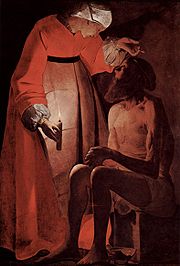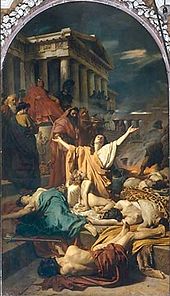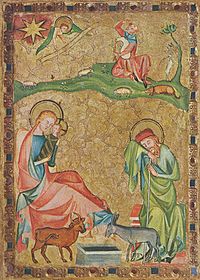- List of names for the biblical nameless
-
Nicolas Poussin's Moses rescued from the Nile (1638) shows Pharaoh's daughter, who is unnamed in the Bible, but called Bithiah in Jewish tradition.

This list provides names given in Jewish, Islamic or Christian tradition for characters who are unnamed in the Bible.
Hebrew Bible/Old Testament
Wives of the antediluvian patriarchs
Patriarch Wife Cain Âwân
Nod [1]Seth Azûrâ Enos Nôâm Kenan Mûalêlêth Mahalalel Dinah Jared Baraka Enoch Edna Methuselah Edna Lamech (Seth's line) Betenos Noah Emzârâ
Naamah [1]See also: Antediluvian- Source: the book of Jubilees (part of the Oriental Orthodox deuterocanon)
- Appears in the Bible at: Genesis 4-5
The book of Jubilees provides names for a host of unnamed biblical characters, including wives for most of the antediluvian patriarchs. The last of these is Noah's wife, to whom it gives the name of Emzara. Other Jewish traditional sources contain many different names for Noah's wife.
The book of Jubilees says that Awan was Adam and Eve's first daughter. Their second daughter Azura married Seth.
For many of the early wives in the series, Jubilees notes that the patriarchs married their sisters.
The Cave of Treasures and the earlier Kitab al-Magall (part of Clementine literature) name entirely different women as the wives of the patriarchs, with considerable variations among the extant copies.
The Muslim historian Ibn Ishaq (c. 750), as cited in al-Tabari (c. 915), provides names for these wives that are generally similar to those in Jubilees; however he makes them Cainites rather than Sethites, despite clearly stating elsewhere that none of Noah's ancestors were descended from Cain.
Cain and Abel's sisters
See also: Cain and Abel- Name: Calmana
- source: Golden Legend [2] which also tells stories about many of the saints
- Appears in the Bible at: Genesis 4:17
- Name: Delbora
- source: Golden Legend [2] which also tells stories about many of the saints
- Appears in the Bible at: Genesis 4
See also: Balbira & Kalmana for alternate traditions of names.
Noah's wife
See also: Noah- Name: Naamah
- Source: Middrash Genesis Rabah 23:4
- Appears in the Bible at: Genesis 4:22; Gen. 7:7
Daughter of Lamech and Zillah and sister of Tubal-cain (Gen. iv. 22). According to Abba ben Kahana, Naamah was Noah's wife and was called "Naamah" (pleasant) because her conduct was pleasing to God. But the majority of the rabbis reject this statement, declaring that Naamah was an idolatrous woman who sang "pleasant" songs to idols.
See also Wives aboard the Ark for a list of traditional names given to the wives of Noah and his sons Shem, Ham, and Japheth.
Daughter of Ham
- Name: Egyptus
- Source: Book of Abraham
The Mormon Book of Abraham, first published in 1842, mentions the name of Egyptus (Abraham 1:23) as being Ham's wife; his daughter apparently has the same name (v. 25).
Nimrod's wife
See also: Nimrod (Bible)- Name: Semiramis
- Source: The Two Babylons by Alexander Hislop
A large body of legend has attached itself to Nimrod, whose brief mention in Genesis merely makes him "a mighty hunter before the Lord". These legends usually make Nimrod to be a sinister figure, and they reach their peak in Hislop's The Two Babylons, which make Nimrod and Semiramis to be the original authors of every false and pagan religion.
Mother of Abraham
- Name: Amthlai bath (daughter of) Khrubu
- Source: Babylonian Talmud Tractate Baba Bathra Chapter 5[3]
- Appears in the Bible at: Book of Genesis
Lot's daughters
- Names: Pheiné and Thamma
- Source:
- Name: Paltith
- Source: Book of Jasher 19:24
[4] - Appears in the Bible at: Book of Genesis
Lot's wife
- Name: Ado ( or Edith )
- Source: Book of Jasher 19:52
[4] - Appears in the Bible at: Book of Genesis
Laban's wife
- Name: Adinah
- Source: Book of Jasher 28:28
[5] - Appears in the Bible at: Book of Genesis
Potiphar's wife
 Joseph and Potiphar's Wife, by Guido Reni 1631
Joseph and Potiphar's Wife, by Guido Reni 1631 See also: Potiphar
See also: Potiphar- Name: Zuleika or Zulaikha
- Source: The Sefer Hayyashar, a book of Jewish lore published in Venice in 1625. [1]
- Appears in the Bible at: Genesis 39:12
Potiphar's wife attempted to seduce Joseph in Egypt.
Pharaoh's daughter
- Name: Merris
- Source: Eusebius of Caesarea (Preparation for the Gospel 9.15)
- Name: Merrhoe
- Source: Eustathius of Antioch (Commentary on Hexameron MPG 18.785)
- Name: Thermutis
- Source: Flavius Josephus
Pharaoh's daughter, who drew Moses out of the water, is known as Bithiah in Jewish tradition (identifying her with the "Pharaoh's daughter Bithiah" in 1 Chronicles 4:18).
Simeon's wife
- Name: Bunah
- Source: Book of Jasher 34:36[6] Legends of the Jews Volume 1 Chapter 6 [7]
- Appears in the bible at: Genesis
Pharaoh's magicians
- Names: Jannes and Jambres
- Source: 2 Timothy 3:8,[8] Book of Jasher chapter 79[9] Antiquities of the Jews Book 2 [10] Aquarian Gospel of Jesus the Christ Chapter 109 [11] Ante-Nicene Fathers, Vol. VIII[12] Easton's Bible Dictionary[13] The Book of the Bee Chapter 30 [14] Nicene and Post-Nicene Fathers, Vol. XIII [15] Legends of the Jews Volume 2 Chapter 4,[16] Chronicles of Jerahmeel, Papyrus Chester Beatty XVI: The Apocryphon of Jannes and Jambres
- Appears in the Bible at: Exodus 7
The names of Jannes and Jambres, or Jannes and Mambres, were well known through the ancient world as magicians. In this instance, nameless characters from the Hebrew Bible are given names in the New Testament. Their names also appear in numerous Jewish texts.
The Cushitic wife of Moses
- Name: Tharbis
- Source: Flavius Josephus, Jewish Antiquities, Book II, Chapter 10 [17]
- Appears in the Bible at: Numbers 12
- Name: Adoniah
- Source: Book of Jasher, 23.5-25.5
-
- Note: We are expressly told in Exodus 2:21 that Moses was given for his wife, Zipporah, the daughter of Reuel (aka. Jethro) the Midianite, the priest of Midian. We are not expressly told that he married anyone else. It is possible for Zipporah to be of Cushite/Ethiopian ancestry if Reuel's wife was an Ethiopian, or even the mind-staggering possibility that Abraham's 3rd wife Keturah was an Ethiopian. (His 2nd wife Hagar was an Egyptian.)
Job's wife
- Names: Sitis, Dinah
- Source: The apocryphal Testament of Job [18]
- Appears in the Bible at: Book of Job
Apocryphal Jewish folklore says that Sitis, or Sitidos, was Job's first wife, who died during his trials. After his temptation was over, the same sources say that Job remarried Dinah, Jacob's daughter who appears in Genesis.
- Name: Raḥma
- Source: Islamic tradition[19]
The source does not tell which wife of Job has this name.
Samson's mother
- Name: Z'llpunith
- Source: Babylonian Talmud Tractate Baba Bathra Chapter 5[3]
- Appears in the Bible at: Book of Judges 13
Jephthah's daughter
- Name: Seila
- Source: Liber Antiquitatum Biblicarum
- Name: Adah
- Source: Order of the Eastern Star[20]
- Appears in the Bible at: Judges 11
The Liber Antiquitatum Biblicarum falsely ascribes itself to the Jewish author Philo. It in fact did not surface until the sixteenth century; see Works of Philo.
The Witch of Endor
 Saul and the Witch of Endor by Jacob Cornelisz van Oostsanen, 1526.
Saul and the Witch of Endor by Jacob Cornelisz van Oostsanen, 1526. See also: Witch of Endor
See also: Witch of Endor- Name: Zephaniah
- Source: A Rabbinical midrash[21]
- Name: Sedecla
- Source: Liber Antiquitatum Biblicarum
- Appears in the Bible at: 1 Samuel 28
According to a midrash on 1 Samuel 28, Zephaniah was the mother of Abner, Saul's cousin, and a military commander in Saul's army. (See 1 Samuel 14)
David's mother
- Name: Nzb'th daughter of Edal
- Source: Babylonian Talmud Tractate Baba Bathra Chapter 5 (folio 91a)[3]
- Appears in the Bible at: Book of Samuel
The Queen of Sheba
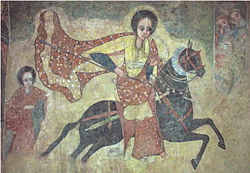 An Ethiopian fresco of the Queen of Sheba travelling to Solomon.
An Ethiopian fresco of the Queen of Sheba travelling to Solomon. See also: Queen of Sheba
See also: Queen of Sheba- Name: Makeda
- Source: Traditional Ethiopian lore surrounding Emperor Menelik I; see the Kebra Nagast
- Name: Nicaule
- Source: Josephus
- Name: Bilqis
- Source: Islamic traditions
- Appears in the Bible at: 1 Kings 10; 2 Books of Chronicles 9
According to Ethiopian traditions, the Queen of Sheba returned to Ethiopia pregnant with King Solomon's child. She bore Solomon a son that went on to found a dynasty that ruled Ethiopia until the fall of Emperor Haile Selassie in 1974.
Haman's mother
- Name: Amthlai daughter of Urbthi
- Source: Babylonian Talmud Tractate Baba Bathra Chapter 5[3]
- Appears in the Bible at: Book of Esther
Apocrypha/Deuterocanonical books
The Deuterocanonical books, sometimes called the "Apocrypha", are considered canonical by Catholics, Eastern Orthodox, and Oriental Orthodox (though with slightly different lists of books), but are considered non-canonical by Protestants.
The woman with seven sons
The woman with seven sons is a Jewish martyr who is unnamed in 2 Maccabees 7, but is named Hannah, Miriam, Shamuna and Solomonia in other sources. According to Eastern Orthodox tradition, her sons, the "Holy Maccabean Martyrs" (not to be confused with the martyrs in the Ethiopian book of Meqabyan), are named Abim, Antonius, Gurias, Eleazar, Eusebonus, Alimus and Marcellus.
The seven Archangels
Tobit 12:15 reads "I am Raphael, one of the seven holy angels, which present the prayers of the saints, and which go in and out before the glory of the Holy One."[22] Of the six unnamed archangels, Michael is named in the Book of Daniel, and Gabriel is named in the Gospel of Luke.
The Book of Enoch, deuterocanonical in the Ethiopian Orthodox Church, names the remaining four archangels Uriel, Raguel, Zerachiel, and Ramiel.[23] Other sources name them Uriel, Izidkiel, Haniel, and Kepharel.[24] In the Coptic Orthodox Church the names of these four archangels are given as Suriel, Sedakiel, Sarathiel and Ananiel. Several other sets of names have also been given.
New Testament
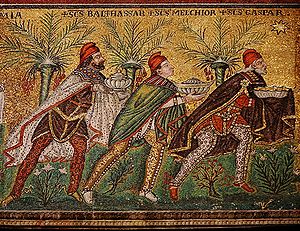 The Three Wise Men are given the names Caspar, Melchior, and Balthasar in this late 6th century mosaic from the Basilica of Saint Apollinarius in Ravenna, Italy.
The Three Wise Men are given the names Caspar, Melchior, and Balthasar in this late 6th century mosaic from the Basilica of Saint Apollinarius in Ravenna, Italy.
The Magi
Main article: Biblical Magi- Names: Balthasar, Melqon, Gaspar
- Source: Armenisches Kindheitsevangelium [25]
- Names: Balthasar, Melchior, and Caspar (or Gaspar)
- Source: European folklore
- Names: Hor, Basanater, and Karsudan
- Source: The Book of Adam, an apocryphal Ethiopian text
- Appear in the Bible at: Matthew 2
The Gospel does not state that there were, in fact, three magi or when exactly they visited Jesus, only that multiple magi brought three gifts: gold, frankincense, and myrrh. Nevertheless, the number of magi is usually extrapolated from the number of gifts, and the three wise men are a staple of Christian nativity scenes. While the European names have enjoyed the most publicity, other faith traditions have different versions. According to the Armenisches Kindheitsevangelium, the three magi were brothers and kings, namely Balthasar, king of India; Melqon, king of Persia; and Gaspar, king of Arabia. The Chinese Christian Church believes that the astronomer Liu Shang was one of the wise men.
The Nativity shepherds
Main article: Annunciation to the shepherds- Names: Asher, Zebulun, Justus, Nicodemus, Joseph, Barshabba, and Jose
- Source: The Syrian Book of the Bee
- Appear in the Bible at Luke 2
The Book of the Bee was written by Bishop Shelemon in the Aramaic language in the thirteenth century.
Sisters/step-sisters/female cousins of Jesus
- Names: Maria
- Source: Gospel according to Phillipus [26]
- Names: Lysia and Lydia
- Source: History of Joseph the Carpenter [27]
- Names: Maria or Anna, Salomé
- Source: Epiphanus[27]
The fact that Jesus had at least two sisters/stepsisters/female cousins is mentioned in Mark 3, 32–34 and Matthew 12, 50, though their exact number is not specified in either gospel. In addition, the various versions of Epiphanus differ on whether one of the sisters was named Maria or Anna.
Herodias' daughter
- Name: Salome
- Source: The Jewish Antiquities of Josephus[28]
- Appears in the Bible at: Matthew 14, Mark 6
Syrophoenician woman
- Name: Justa
- Source: 3rd century pseudo-Clementine homily
- Appears in the Bible at: Matthew 15, Mark 7
According to the same source, her daughter was Berenice.
Hæmorrhaging woman
- Name: Bernice
- Source: The apocryphal Acts of Pilate
- Name: Veronica
- Source: Latin translation of the Acts of Pilate
- Appears in the Bible at: Matthew 9:20–22
Veronica is a Latin variant of Berenice (Greek: Βερενίκη). According to the Acts of the Apostles, Veronica or Berenice obtained some of Jesus' blood on a cloth at the Crucifixion. Tradition identifies her with the woman who was healed of a bleeding discharge in the Gospel (see also: Veil of Veronica).
Samaritan woman at the well
- Name: Photina
- Source: Eastern Orthodox Church Tradition
- Appears in the Bible at: John 4:5-42
In the tradition of the Eastern Orthodox Church, the woman at the well became a follower of Christ, was baptized, proclaimed the Gospel over a wide area, and was later martyred. She is recognized as a saint in the Eastern Orthodox Church.
Damned rich man
- Name: Phineas
- Source: Pseudo-Cyprian, De pascha computus
- Name: Dives
- Source: European Christian folklore
- Appears in the Bible at: Luke 16:19-16:31
Dives is simply Latin for "rich", and as such may not count as a proper name. The story of the blessed Lazarus and the damned rich man is widely recognised under the title of Dives and Lazarus, which may have resulted in this word being taken for a proper name.
Woman taken in adultery
- Name: Mary Magdalene
- Source: Western Christian tradition
- Appears in the Bible at: John 8
A long standing Western Christian tradition first attested by Pope Gregory I identifies the woman taken in adultery with Mary Magdalene, and also with Mary of Bethany.[29] Jesus had exorcised seven demons out of Mary Magdalene (Mark 16:9), and Mary Magdalene appears prominently in the several accounts of Jesus' entombment and resurrection, but there is no indication in the Bible that clearly states that Mary Magdalene was the same person as the adulteress forgiven by Jesus. Roman Catholics also have identified Mary Magdalene as the weeping woman who was a sinner, and who anoints Jesus' feet in Luke 7:36-50, and while the Church has dropped this interpretation to a degree, this remains one of her more famous portrayals.
The Eastern Orthodox Church has never identified Mary Magdalene as either the woman taken in adultery, or the sinful woman who anointed Jesus' feet.
The man born blind
- Name: Celidonius
- Source: Christian tradition
- Appears in the Bible at: John 9:1-38
Pontius Pilate's wife
Main article: Pontius Pilate's wife- Name: Claudia, Procla, Procula, Perpetua or Claudia Procles
- Source: European folklore; Dolorous Passion of our Lord Jesus Christ (as "Claudia Procles")[30]
- Appears in the Bible at: Matthew 27:19
During the trial of Jesus the wife of Pontius Pilate sent a message to him saying, "Have nothing to do with that just man; for I have suffered many things this day in a dream because of him."
The proposed names of Procla and Procula may not be names at all, but simply a form of Pilate's official title of Procurator, indicating that she was the Procurator's wife.
Thieves crucified with Jesus
- Names: Zoathan and Chammata
- Source: Gospel of Mark (Latin addition to the Greek text)[31]
- Names: Zoatham and Camma
- Source: Gospel of Matthew (Latin addition to the Greek text)[32]
- Names: Joathas and Maggatras
- Source: Gospel of Luke (Latin addition to the Greek text)[33]
- Names: Titus and Dumachus
- Source: Arabic Gospel of the Infancy of the Saviour
- Names: Dismas and Gestas (or, Gesmas)
- Source: Acts of Pilate
- Appears in the Bible at: Matthew 27, Mark 15, Luke 23
Dismas is revered as a saint under that name by Roman Catholics.
Soldier who pierced Jesus with a spear
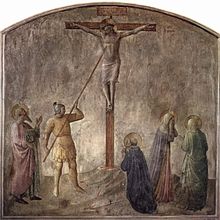 Jesus' side is pierced with a spear, Fra Angelico (c. 1440), Dominican monastery of San Marco, Florence.
Jesus' side is pierced with a spear, Fra Angelico (c. 1440), Dominican monastery of San Marco, Florence.
- Name: Longinus
- Source: Acts of Pilate
- Appears in the Bible at: John 19:34
In tradition he is called Cassius before his conversion to Christianity.[34] The Lance of Longinus, also known as the Spear of Destiny, is supposedly preserved as a relic, and various miracles are said to be worked through it.
Man who offered Jesus vinegar
- Name: Stephaton
- Source: Codex Egberti, 10th century
- Appears in the Bible at: Matthew 27:48, Mark 15:36, & John 19:29-19:30
Guard(s) at Jesus' tomb
- Name: Petronius
- Source: Apocryphal Gospel of Peter
- Names: Issachar, Gad, Matthias, Barnabas, Simon
- Source: The Book of the Bee
- Appears in the Bible at: Matthew 27:62–66
See also
- Non-canonical books referenced in the Bible
- Seventy Disciples
- Brother of Jared
- Tiberius Iulius Abdes Pantera, sometimes alleged to be the father of Jesus.
Notes
- ^ a b Nod's Land
- ^ a b Medieval Sourcebook: The Golden Legend: Volume 1 (full text)
- ^ a b c d The Babylonian Talmud, Rodkinson tr., Book 7.: Tract Baba Bathra, Part I: Chapter V
- ^ a b Book of Jasher, Chapter 19
- ^ Book of Jasher, Chapter 28
- ^ Book of Jasher, Chapter 34
- ^ Chapter VI: Jacob
- ^ BibleGateway.com - Passage Lookup: 2 Timothy 3:8
- ^ Book of Jasher, Chapter 79
- ^ http://www.sacred-texts.com/jud/josephus/ant-2.htm
- ^ Chapter 106
- ^ Ante-Nicene Fathers, Vol VIII: Apocrypha of the New Testament.: Chapter 5
- ^ Easton's Bible Dictionary
- ^ Chapter XXX - The History of Moses' Rod
- ^ Nicene and Post-Nicene Fathers, Vol. XIII: The Homilies of St. John Chrysostom on Timothy, Titus, and Philemon.: 2 Timothy 3:1-7
- ^ Chapter IV: Moses in Egypt
- ^ http://sacred-texts.com/jud/josephus/ant-2.htm
- ^ JewishEncyclopedia.com - JOB, TESTAMENT OF:
- ^ Eric Geoffroy et Néfissa Geoffroy : Le grand livre des prénoms arabes - Plus de 5500 prénoms classés par thèmes avec leurs correspondances en français, Albin Michel, 2009.
- ^ Adah, South Carolina Order of the Eastern Star website.
- ^ JewishEncyclopedia.com - ENDOR, THE WITCH OF
- ^ Tobit 12:15.
- ^ Enoch XX.
- ^ James Hastings, A Dictionary of the Bible: Volume IV, Part I: Pleroma–Shimon, 1898, reprinted 2004 by the Minerva Group, ISBN 1410217280, p. 202 (RAPHAEL).
- ^ Wilhelm Schneemelcher, Neutestamentarische Apokryphen. In deutscher Übersetzung: 2 Bde., Mohr Siebeck; 1999
- ^ Wilhelm Schneemelcher, Neutestamentarische Apokryphen. In deutscher Übersetzung: 2 Bde., Mohr Siebeck; 1999, Vol. 1, p. 159
- ^ a b Wilhelm Schneemelcher, Neutestamentarische Apokryphen. In deutscher Übersetzung: 2 Bde., Mohr Siebeck; 1999, Vol. 1, p. 363
- ^ "Antiquities of the Jews - Book XVIII". Sacred-texts.com. http://sacred-texts.com/jud/josephus/ant-18.htm. Retrieved 2010-08-12.
- ^ Italians find 'Jesus' foot salve', Dec 10, 2008
- ^ Dolorous Passion Of Our Lord Jesus Christ
- ^ Nomine Zoathan et nomine Chammata; in: Codex Colbertinus, 4051 (Lat. 254), National Library, Paris
- ^ Nomine Zoatham et nomine Camma; in: Codex Colbertinus, 4051 (Lat. 254), National Library, Paris
- ^ Joathas et Maggatras; Codex Rehdigeranus 169, National Library, Berlin (Depot Breslau 5); facsimile: Library of the University of Basel, A. N. IV.2
- ^ "Longinus", in: Johann Evangelist Stadler et al., Vollständiges Heiligen-Lexikon, 1858-1882 (reprint: Hildesheim, 1996)
For further reference
- "Names for the Nameless", in The Oxford Companion to the Bible, Bruce M. Metzger and Michael D. Coogan, editors. ISBN 0-19-504645-5
- "The Poem of the Man God", Centro Editoriale Valtortiano srl, Maria Valtorta. (5 Volumes) no ISBN.
Categories:- Christian folklore
- Jewish folklore
- Lists of names
- Hebrew Bible people
- Bible-related lists
- Unidentified people
Wikimedia Foundation. 2010.


